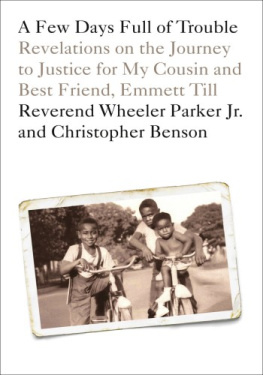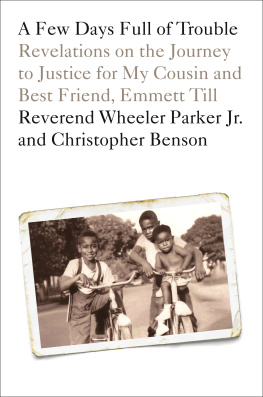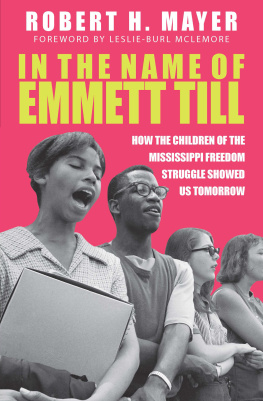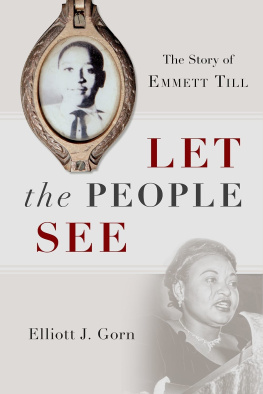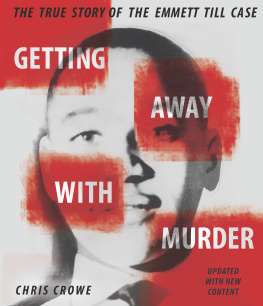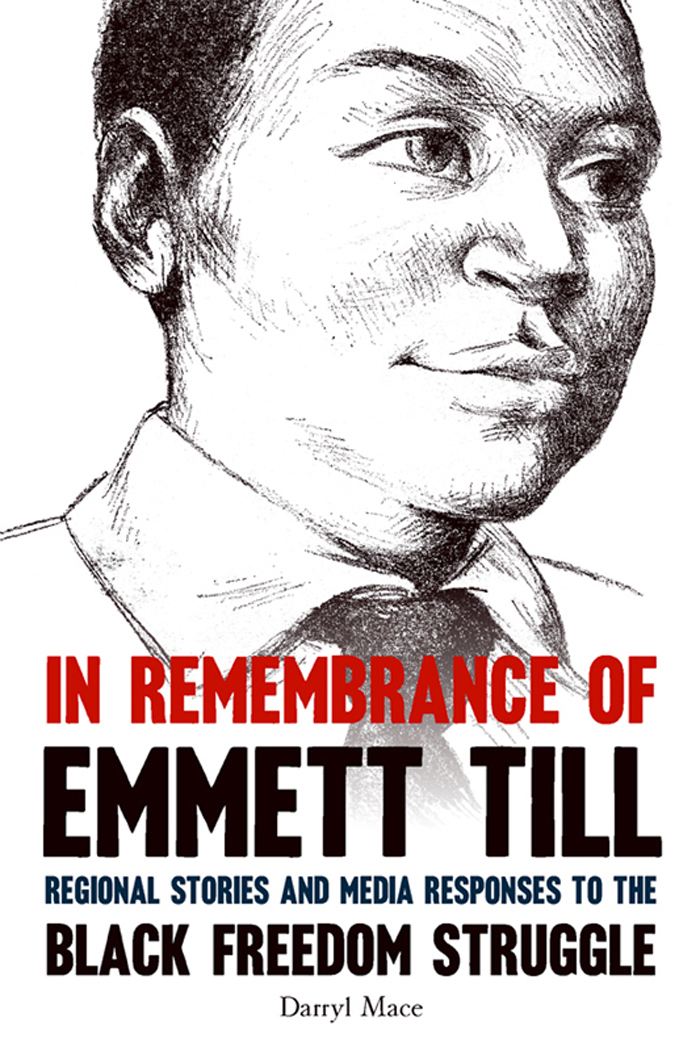In Remembrance of
Emmett Till
IN REMEMBRANCE OF
EMMETT TILL
Regional Stories
and Media Responses
to the Black Freedom Struggle
D ARRYL M ACE

Due to variations in the technical specifications of different electronic reading devices, some elements of this ebook may not appear as they do in the print edition. Readers are encouraged to experiment with user settings for optimum results.
Copyright 2014 by The University Press of Kentucky
Scholarly publisher for the Commonwealth,
serving Bellarmine University, Berea College, Centre College of Kentucky, Eastern Kentucky University, The Filson Historical Society, Georgetown College, Kentucky Historical Society, Kentucky State University, Morehead State University, Murray State University, Northern Kentucky University, Transylvania University, University of Kentucky, University of Louisville, and Western Kentucky University.
All rights reserved.
Editorial and Sales Offices: The University Press of Kentucky
663 South Limestone Street, Lexington, Kentucky 40508-4008
www.kentuckypress.com
Library of Congress Cataloging-in-Publication Data
Mace, Darryl, 1975
In remembrance of Emmett Till : regional stories and media responses to the Black freedom struggle / Darryl Mace.
pages cm
Includes bibliographical references and index.
ISBN 978-0-8131-4536-5 (hardcover : acid-free paper)
ISBN 978-0-8131-4538-9 (PDF) ISBN 978-0-8131-4537-2 (ePub)
1. Till, Emmett, 1941-1955Death and burialPress coverage. 2. Lynching MississippiPress coverage. 3. Trials (Murder)MississippiSumnerPress coverage. 4. Mass mediaPolitical aspectsMississippiHistory20th century. 5. JournalismPolitical aspectsMississippiHistory20th century. 6. Memorials Political aspectsMississippiHistory20th century. 7. African AmericansCivil rightsSouthern StatesHistory20th century. 8. Southern StatesRace relations History20th century. 9. RacismUnited StatesPublic opinionHistory20th century. 10. Public opinionUnited StatesHistory20th century. I. Title.
E185.93.M6M24 2014
364.1'34dc23
2014010708
This book is printed on acid-free paper meeting
the requirements of the American National Standard
for Permanence in Paper for Printed Library Materials.

Manufactured in the United States of America.
 | Member of the Association of American University Presses |
To the love of my life, Nikki Mace.
I thank God every day that he brought us together.
Thank you for your constant support and for reading
countless drafts of this manuscript while it was still
in a very rough format.
Contents
Preface
Fourteen-year-old Emmett Louis Till left his mothers Chicago home on August 20, 1955, to vacation with his great-uncle Moses Wright and his family in Mississippi. Tills relatives stopped the burial and ensured that the body was returned to Chicago, where his mother, Mamie Till-Mobley, insisted that the pine box containing her sons remains be opened. She inspected the body and confirmed that it was indeed that of Emmett Till.
Subsequently, Mamie Till-Mobley held a public open-casket wake and funeral. Her efforts memorialized the lynching and turned the publics critical eyes toward the state of Mississippi. Bryant and Milam, who had been questioned and arrested on August 29, 1955, were indicted by a grand jury and stood trial on the charge of murder. During the brief trial, the jury heard testimony from black Mississippians who, fed up with business as usual, risked life and limb by naming white perpetrators in a white-on-black crime. Equally endangered, the black Chicagoan Mamie Till-Mobley traveled to the heart of Dixie to testify for the prosecution. The defense presented testimony from Sheriff Strider and expert witnesses, all of whom claimed that the body was too decomposed to have been in the river for only three days and that it was too large to be that of a fourteen-year-old boy. The defense also called Carolyn Bryant to the witness stand, but the presiding judge, Curtis Swango, dismissed the jury during her testimony and later ruled that it would not hear her account of the incident. Finally, both sides rested, and the jury retired to discuss the case. After roughly an hour of deliberation, it returned a verdict of not guilty, but Bryant and Milam still faced kidnapping charges. In November 1955, the two men appeared before a grand jury in Leflore County on the charge of kidnapping, but they were never indicted. They returned to their lives after the trial.
This brief historical narrative only scratches the surface of the intrigues, deceptions, horrors, and legacies surrounding the case. To this day, there are many conflicting stories circulating about the death of Emmett Till. Surely, very few, if any, living persons know exactly what happened throughout the saga. Amid the countless assertions and outright lies about events surrounding the lynching, it is nearly impossible to find the actual, objective truth as many scholars would define it. However, the argument that I present in this book rests on the assumption that any truth that we might find about the incident is of necessity subjective and that the many people who were influenced by the lynching and the subsequent events created their own memories of the case. For most, these memories, and, thus, their truth of Emmett Till, were based on the actual coverage, and their recollections of the coverage, in national and local print media sources. Doubtlessly, the Till lynching engendered an unprecedented media firestorm with regard to race relations in the United States. The death of Emmett Till brought the full weight of the legacy of institutionalized slavery, Jim Crow segregation, and vitriolic white supremacy to bear on the consciences of countless Americans of all races. It fully opened the eyes of many to the untenable situations that racial politics created in this country and inspired a generation of activists to challenge the system of white racial hegemony wherever it existed.
This book lives as a legacy to the too-short life and tragic death of that fourteen-year-old boy. It stands as a memorial to the countless activists who, emboldened by his death, leaped into the struggle for civil rights. It underscores how regional stories and racial dispositions framed the coverage of, and responses to, his lynching. And it remains a tribute to the work of Tills relatives (especially his mother), civil rights organizations, and the black press to honor his death, commemorate his life, galvanize a generation of activists, and push for civil rights for all Americans.
Introduction
While never referred to as the crime of the century, the kidnapping and lynching of Emmett Louis Till captured the countrys imagination and sent waves of outrage through the public. It engendered a visceral response from many progressive-minded individuals, and the comprehensive coverage by the regional and national press emboldened a generation of activistsdubbed the Emmett Till generationto speak out and act out in remembrance of Emmett Till. Till was not the first black male murdered in the South, but because he was a youth and a northerner his death fanned the flames of regionalism and regional tension in this country. More importantly, his August 1955 murder occurred in the wake of the May 1954


